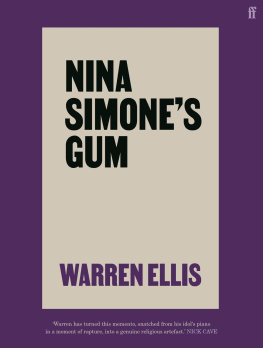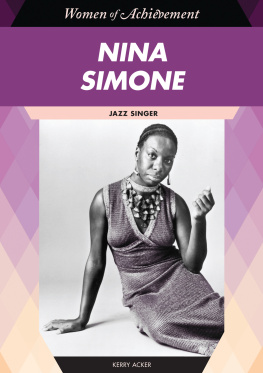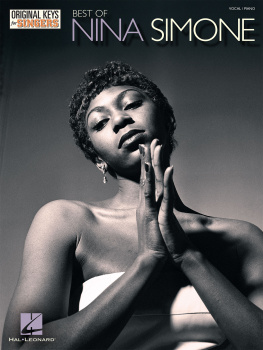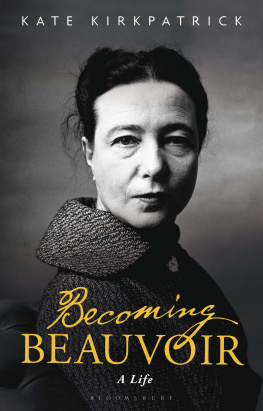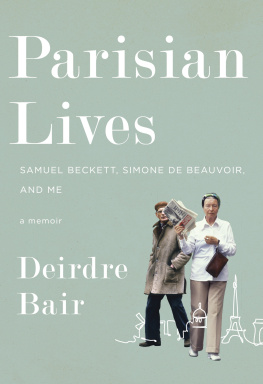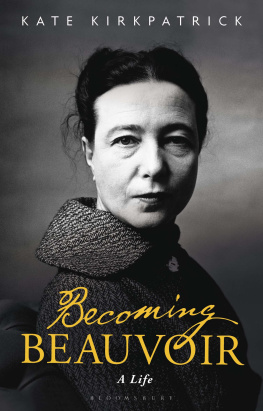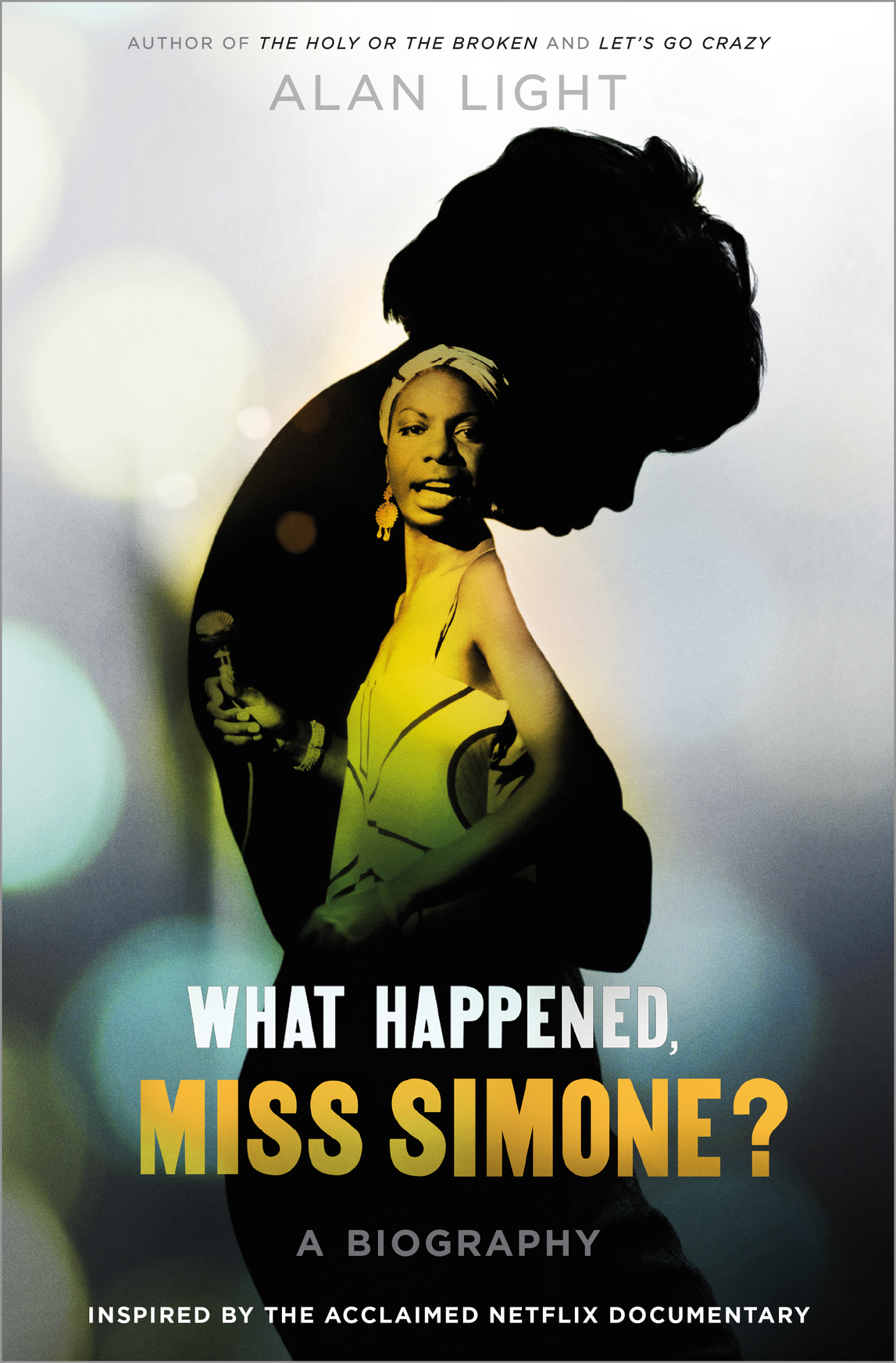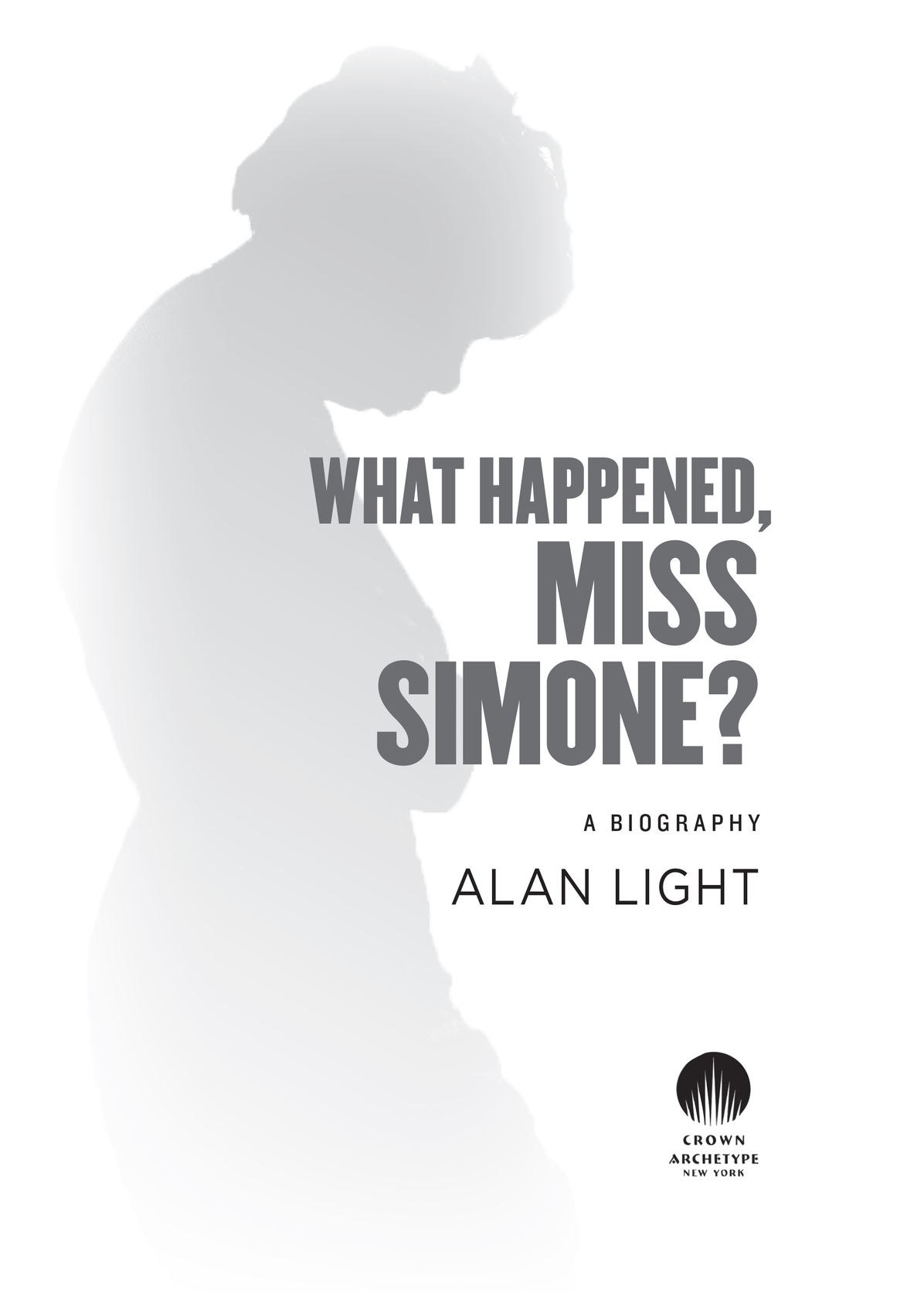All rights reserved.
Published in the United States by Crown Archetype, an imprint of the Crown Publishing Group, a division of Penguin Random House LLC, New York.
Crown Archetype and colophon is a registered trademark of Penguin Random House LLC.
Names: Light, Alan, author.
Title: What happened, Miss Simone? : a biography / Alan Light.
Description: New York : Crown Archetype, 2016.
Subjects: LCSH: Simone, Nina, 1933-2003. | Women singersUnited StatesBiography. | SingersUnited StatesBiography. | What happened, Miss Simone? (Motion picture) | BISAC: BIOGRAPHY & AUTOBIOGRAPHY / Composers & Musicians. | BIOGRAPHY & AUTOBIOGRAPHY / Cultural Heritage.
Classification: LCC ML420.S5635 L54 2016 | DDC 782.42164092dc23 LC record available at http://lccn.loc.gov/2015041145
Title page illustration courtesy of Bernard Gotfryd/Courtesy of Lisa Simone Kelly
INTRODUCTION
A re you ready, black people?
In the summer of 1969before, during, and after the three days of peace and music being held at Max Yasgurs farm in Bethel, New Yorkanother all-star outdoor music festival was taking place in Mount Morris Park, northeast of Manhattans Central Park. The Harlem Cultural Festival, also sometimes called the Black Woodstock, happened over the course of six Sunday afternoons from June 29 to August 24, with legends like B.B. King, the Staple Singers, and Sly & the Family Stone playing to an estimated one hundred thousand concertgoers.
Tony Lawrence, a New York nightclub singer and sometime movie actor, was the producer, promoter, and host of the events. On campuses and in black neighborhoods throughout the country, unrest and upheaval were at a fever pitch, so while the citys mayor John Lindsay spoke at the event (and was introduced as a blue-eyed soul brother), the New York Police Department refused to provide security for the concerts. In their stead, a delegation of Black Panthers managed the crowds.
At one of the July shows, Jesse Jackson addressed the throngs of people. As I look out at us rejoice today, he said, I was hoping it would be in preparation for the major fight we as a people have on our hands here in this nation. Some of you are laughing because you dont know any better, and others laughing because you are too mean to cry. But you need to know that some mean stuff is going down. A lot of you cant read newspapers. A lot of you cant read books, because our schools have been mean and left us illiterate or semiliterate. But you have the mental capacity to read the signs of the times.
It was a time of joy and danger, of liberation and fear, testing the opportunities and the limits of empowerment. And no performance over those six summer Sundays would capture the moment, in all its contrasts, more than the appearance of Nina Simone.
Are you ready to smash white things? Burn buildings? Are you ready?
Are you ready to build black things?
Simones concert came near the end of the series, on August 17. Just a few weeks earlier, she had recorded To Be Young, Gifted and Black, inspired by the memory of her friend and mentor Lorraine Hansberry, an anthem of hope for the future of a civil rights movement that had already been battered and ripped apart by murders, philosophical and tactical divisions, and government interference; still, the song would be named the Black National Anthem by the Congress of Racial Equality and covered by Aretha Franklin and Donny Hathaway.
When she took the stage at Mount Morris Parkin a long yellow-and-black-print dress, her hair teased into a sort of Afrobouffant, massive silver earrings dangling to her neckshe made explicit the tensions and the possibilities of an event celebrating black culture and black pride in the aftermath of the riots that had erupted in urban areas during the previous summers.
Backed by a loose but propulsive and earnest-looking group of musicians wearing dashikis, she dug into a set focused on protest material of various moods: the brand-new To Be Young, Gifted and Black; Four Women, her controversial examination of the black female experience, and the insidious power held by varying black skin tones, in America; a fiery new song titled Revolution, with the refrain Dont you know its going to be all right, borrowed from the Beatles hit of the same name; the joyous Aint Got NoI Got Life medley, from the American Tribal Love-Rock Musical Hair, which had opened on Broadway the previous year and was still running, about seventy blocks south of the Harlem stage.
But it was the final number of her performance, a recitation of Are You Ready, Black People?, the battle cry written by David Nelson of the proto-rap group the Last Poets, that would define Simones performance for history. I did not memorize enough, so I have to read it, she told the crowd. Its for you. And as her band banged out a rhythm on the congas and chanted, Yes, Im ready, in response to the poems questions, she bit down on Nelsons words.
Are you ready to change yourself?You know what Im talking about.
Are you ready to go inside yourself and change yourself?
The Harlem audience yelled its approval. They shouted affirmations at the challenge to smash white things, to go inside yourself and change yourself. Simone built the poem to a climax, then said quietly, See you later. She left the stage as the band kept the groove going.
But once again, on that day and the days that followed, true revolutionary action failed to materialize; the chaos the crowd chanted about did not ensue. And whether or not she still literally believed in her musics power to inspire social or political change, soon thereafter, Nina Simonewho often referred to herself as the only singer in the civil rights movementwould reach a breaking point in her frustration with America and with what she saw as the dwindling potential of true black progress.
We had no leaders, she would say in 1989. Lorraine Hansberry was dead, Langston Hughes was dead, Eldridge Cleaver was in jail. Paul Robeson was long since been dead, Stokely Carmichael was gone, Malcolm X was dead, and Martin Luther King was dead. We had nobody left.
On top of the scarcity of true visionaries, Simone was also disappointed with the men in the Student Non-violent Coordinating Committee, who she had been hoping would take up arms and lead a real revolution. I became very disillusioned about it all, she recalled. I felt that there was no more movement anymore, and that I wasnt part of anything. Earlier in her life, she had invested years into the dream of becoming Americas first great black classical pianist; after the disappointment of abandoning that aspiration, she was losing hope in her second grand ambitionthe struggle for racial equality that had dominated her recent work.




